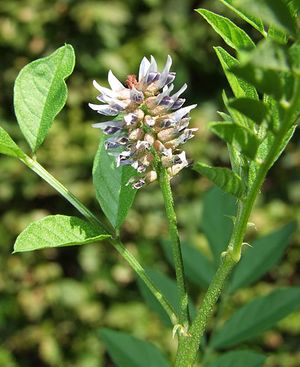Note: This is a project under development. The articles on this wiki are just being initiated and broadly incomplete. You can Help creating new pages.
Difference between revisions of "Glycyrrhiza glabra - Yashtimadhu"
| Line 4: | Line 4: | ||
==Uses== | ==Uses== | ||
| − | {{Uses|Arthritis}}, {{Uses|Mouth ulcers}}, {{Uses|Cough}}, {{Uses|Asthma}}, {{Uses|Bronchitis}}, {{Uses|Blotches}}, {{Uses|Peptic ulcer}}, {{Uses|Allergic complaints}}, {{Uses|High blood pressure}}, {{Uses|Kidney disease}}, {{Uses|Herpes}} | + | {{Uses|Arthritis}}, {{Uses|Mouth ulcers}}, {{Uses|Cough}}, {{Uses|Asthma}}, {{Uses|Bronchitis}}, {{Uses|Blotches}}, {{Uses|Peptic ulcer}}, {{Uses|Allergic complaints}}, {{Uses|High blood pressure}}, {{Uses|Kidney disease}}, {{Uses|Herpes}}, {{Uses|Acidity}} |
==Parts Used== | ==Parts Used== | ||
Revision as of 12:42, 13 September 2018
Glycyrrhiza glabra is the root of Glycyrrhiza glabra from which a sweet flavour can be extracted. The liquorice plant is a herbaceous perennial legume native to southern Europe and parts of Asia, such as India. It is not botanically related to anise, star anise, or fennel, which are sources of similar flavouring compounds.
Contents
- 1 Uses
- 2 Parts Used
- 3 Chemical Composition
- 4 Common names
- 5 Properties
- 6 Habit
- 7 Identification
- 8 List of Ayurvedic medicine in which the herb is used
- 9 Where to get the saplings
- 10 Mode of Propagation
- 11 How to plant/cultivate
- 12 Commonly seen growing in areas
- 13 Photo Gallery
- 14 References
- 15 External Links
Uses
Arthritis, Mouth ulcers, Cough, Asthma, Bronchitis, Blotches, Peptic ulcer, Allergic complaints, High blood pressure, Kidney disease, Herpes, Acidity
Parts Used
Chemical Composition
glycosides, glycyrrhizin (about 7%) and glycyrrhizinic acid, triterpenoid glycosides (saponins), flavonoids[1]
Common names
| Language | Common name |
|---|---|
| Kannada | |
| Hindi | |
| Malayalam | |
| Tamil | |
| Telugu | |
| Marathi | NA |
| Gujarathi | NA |
| Punjabi | NA |
| Kashmiri | NA |
| Sanskrit | |
| English | Agrimony |
Properties
Reference: Dravya - Substance, Rasa - Taste, Guna - Qualities, Veerya - Potency, Vipaka - Post-digesion effect, Karma - Pharmacological activity, Prabhava - Therepeutics.
Dravya
Rasa
Madhura (Sweet)
Guna
Guru (Heavy), Snigda (unctous)
Veerya
Sheeta (Cold)
Vipaka
Madhura (Sweet)
Karma
Vata, Pitta
Prabhava
Habit
Identification
Leaf
| Kind | Shape | Feature |
|---|---|---|
| Simple | Divided into 9–17 leaflets, held on a leaf stalk 10–20 cm long |
Flower
| Type | Size | Color and composition | Stamen | More information |
|---|---|---|---|---|
| Unisexual | 1.0–1.5 cm long | violet | 5-20 | The flowers are held in loose, conical spires, almost as long as the leaves |
Fruit
| Type | Size | Mass | Appearance | Seeds | More information |
|---|---|---|---|---|---|
| 1–3 cm long and 4–5 mm wide | Each pod contains 2–5 brown to blackish seeds | With hooked hairs | many | {{{6}}} |
Threats and conservation Widely distributed in Eurasia, Glycyrrhiza glabra is not considered to be threatened. Where it is cultivated as a crop, it is normally harvested in a sustainable manner, although there are some concerns that the commercial harvest of rhizomes can be destructive to naturally occurring populations and their habitats
Other features
List of Ayurvedic medicine in which the herb is used
- Vishatinduka Taila as root juice extract
Where to get the saplings
Mode of Propagation
How to plant/cultivate
Requires a deep well cultivated fertile moisture-retentive soil for good root production[3]
Commonly seen growing in areas
Dry open places, sandy places near the sea.
Photo Gallery
References
External Links
- Ayurvedic Herbs known to be helpful to treat Arthritis
- Ayurvedic Herbs known to be helpful to treat Mouth ulcers
- Ayurvedic Herbs known to be helpful to treat Cough
- Ayurvedic Herbs known to be helpful to treat Asthma
- Ayurvedic Herbs known to be helpful to treat Bronchitis
- Ayurvedic Herbs known to be helpful to treat Blotches
- Ayurvedic Herbs known to be helpful to treat Peptic ulcer
- Ayurvedic Herbs known to be helpful to treat Allergic complaints
- Ayurvedic Herbs known to be helpful to treat High blood pressure
- Ayurvedic Herbs known to be helpful to treat Kidney disease
- Ayurvedic Herbs known to be helpful to treat Herpes
- Ayurvedic Herbs known to be helpful to treat Acidity
- Herbs with Root used in medicine
- Herbs with Leaves used in medicine
- Herbs with common name in English
- Habit - Herb
- Index of Plants which can be propagated by Seeds
- Index of Plants which can be propagated by Cuttings
- Herbs that are commonly seen in the region of Dry open places
- Herbs that are commonly seen in the region of sandy places near the sea
- Herbs







